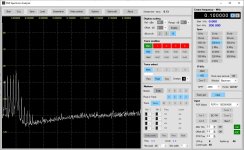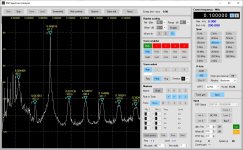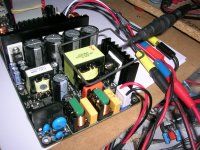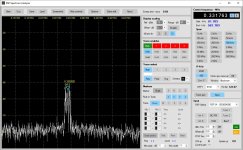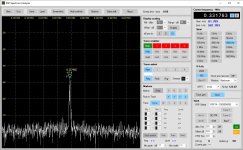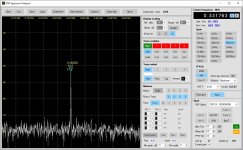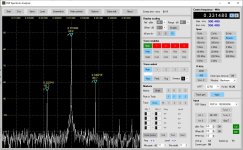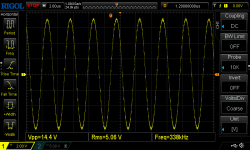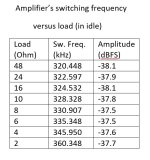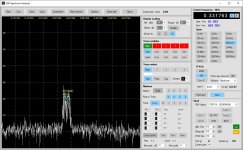And, quick update here:
The universal power supply 2*300W amplifier module is ready for the public now 🙂


The universal power supply 2*300W amplifier module is ready for the public now 🙂
That look impressive. 😎The universal power supply 2*300W amplifier module is ready for the public now
I already have 4 of your 2x150W amps, which are not in full service yet. I'm thinking of either an 8-ch amp with all of those, or a 10-ch amp with 8x150w + 2x300w. This is for 4-way active systems with dual woofers (total 10 drivers for pair). Now I'm wondering about...
1) turn on surge current draw
2) max AC power draw (at full power)
In North Am, we are generally limited to 15A @120Vac per outlet, though some of the outlets in my dedicated studio are fitted with 20A breakers and appropriate wiring.
I know 2) is very unlikely to ever happen with a home audio amp, but it would be good to know what the max AC power is for all of your various amp variants. Esp. for ambitious home theater setups.
Hi, Mike
Thanks for your continuous support for my project. Regarding your questions, here is the answer:
1. This amplifier module has the special SMPS design without the primary capacitor reservior, instead we put the capacitors on the secondary side, so the turn on surge current does not cause any trouble, and somehow you can omit this parameter when design your system.
2. The max AC power draw is near to 800W when driving this amplifier module into maximum output.
Have a nice weekend~
Thanks,
Eric
Thanks for your continuous support for my project. Regarding your questions, here is the answer:
1. This amplifier module has the special SMPS design without the primary capacitor reservior, instead we put the capacitors on the secondary side, so the turn on surge current does not cause any trouble, and somehow you can omit this parameter when design your system.
2. The max AC power draw is near to 800W when driving this amplifier module into maximum output.
Have a nice weekend~
Thanks,
Eric
That suggests efficiency of ~75% -- 800W input for 600W output. I presume that's the same for all the amp variants, so ~400W AC power draw for max output from thee 150Wx2 amps?2. The max AC power draw is near to 800W when driving this amplifier module into maximum output.
Good to know!1. This amplifier module has the special SMPS design without the primary capacitor reservior, instead we put the capacitors on the secondary side, so the turn on surge current does not cause any trouble, and somehow you can omit this parameter when design your system.
Last edited:
That suggests efficiency of ~75% -- 800W input for 600W output. I presume that's the same for all the amp variants, so ~400W AC power draw for max output from the 150Wx2 amps?2. The max AC power draw is near to 800W when driving this amplifier module into maximum output.
Nice calculation, it's true~
I switch on four FFA001V3 modules (2x150W) simultaneously. I have no issue with inrush current.1. This amplifier module has the special SMPS design without the primary capacitor reservior, instead we put the capacitors on the secondary side, so the turn on surge current does not cause any trouble, and somehow you can omit this parameter when design your system.
In these, the primary side capacitor is indeed small (47uF/400V). Secondary side has four 1200uF/80V capacitors.
SMPS switching frequency is 70kHz
George
Attachments
WOW that seems quite low! Are the first 2 screen captures from a oscilloscope? What does it tell you about the amps?SMPS switching frequency is 70kHz
Hi Mike
The spectrum analyser screenshots (FFTs) were taken with a sniffer probe connected at the input of an SDR (SDRplay RSP1A).
Please note that this 70kHz is the switching frequency of the PSU.
Now, the switching frequency of the class D amplifier is much higher >300kHz.
This switching frequency varies with the load connected to the amp and the power supplied to it. See attachments.
1st att. is with oscilloscope probe across load.
Rest att. are FFTs from a small 10mm X 10mm sniffer probe over amplifier output coil
George
The spectrum analyser screenshots (FFTs) were taken with a sniffer probe connected at the input of an SDR (SDRplay RSP1A).
Please note that this 70kHz is the switching frequency of the PSU.
Now, the switching frequency of the class D amplifier is much higher >300kHz.
This switching frequency varies with the load connected to the amp and the power supplied to it. See attachments.
1st att. is with oscilloscope probe across load.
Rest att. are FFTs from a small 10mm X 10mm sniffer probe over amplifier output coil
George
Attachments
It has two SMPS400s. I just took my RKB-D8100 apart, including (of course) removing the panel over the PSUs which says 'Do not remove this cover'. Mine runs hot and consequently noisy on the fans, so I'm going to canibalise it.That's an interesting insight, George! I presume you refer to the Rotel & its UcD180 modules. Can you expand on that? Maybe I can examine & fix these solder points... tho with tiny surface mount components, maybe not. 🙁
Note: I'm pretty sure the noise is not coming from the PSU in the Rotel because 6 of the channels have similar but not identical residual noise, while 2 have none of the buzzing. The primary PSU looks like a Hypex SMPS400, probably 46V out version. I was surprised there's only one to power 8 of the UcD180s. The Rotel's output rating of 50w/ch suggests the 100w/ch version (RKB-8100) simply has a bigger Hypex PSU, or maybe 2 of these SMPS400.
The D8100 (and I assume the plain 8100) has Hypex UCD250LP-OEM amp modules. These are documented here https://www.hypex.nl/products/amplifier-families/ucd-family/ucd250lp-oem as using the same PSUs as the 400 amps. The documentation for the 180s suggest using the 46V SMPS.
Of course!!!Please note that this 70kHz is the switching frequency of the PSU.
Now, the switching frequency of the class D amplifier is much higher >300kHz.
Thanks for confirming.It has two SMPS400s.
Interesting. So Rotel basically underpowered the amp modules and de-rated the power output.I just took my RKB-D8100 apart, including (of course) removing the panel over the PSUs which says 'Do not remove this cover'. Mine runs hot and consequently noisy on the fans, so I'm going to canibalise it.
The D8100 (and I assume the plain 8100) has Hypex UCD250LP-OEM amp modules. These are documented here https://www.hypex.nl/products/amplifier-families/ucd-family/ucd250lp-oem as using the same PSUs as the 400 amps. The documentation for the 180s suggest using the 46V SMPS.
I considered replacing the noisier amp boards. A Canadian pro audio electronics outfit sells UcD180s as replacements for Electro-Voice products. Pretty cheap. But the internal wiring in the Rotel is too extensive for me; I decided to leave it, probably pass it on to someone who won't be bothered by the residual noise, which is still pretty low. I'd rather spend the time building more speakers.
That's interesting data on these amps, thank you!Now, the switching frequency of the class D amplifier is much higher >300kHz.
This switching frequency varies with the load connected to the amp and the power supplied to it. See attachments.
1st att. is with oscilloscope probe across load.
Rest att. are FFTs from a small 10mm X 10mm sniffer probe over amplifier output coil
George
Yep, the Rotel RKB-D8100 and RKB-850 are quite a bit noisy, but if you reduce the gain at the front panel pots, its not too bad at all...the Hypex UCD180LP (RKB-850) and the UCD250LP (RKB-8100) both require the input buffer / preamp circuit, and Rotel may have made the preamp a bit too "hot" for the modules to work quietly...
Thanks, GeorgeYou are welcome Eric.
I wish you success with your new module. 😎
George
We'll try our best to provide good products/service at affordable price here~
Thanks,
Eric
Eric,
Can you give me the pin out on the FFA003 board, and what voltage are you feeding the input board also can you give me the current rating as well.
Bill
Also what is pricing on the universal 2X300 module?
Can you give me the pin out on the FFA003 board, and what voltage are you feeding the input board also can you give me the current rating as well.
Bill
Also what is pricing on the universal 2X300 module?
Hi, MartinErica
I didn't follow up from the beginning, but this module can be used for 70V?
Thanks
It's ok to put your question here directly.
Regarding the 70V application, there are two ways:
1. You can design the output audio xfmr to connect the amplifier, and step up output for 70V output;
2. It can be configured with bridge output to have 70V output, without the xfmr, it calls the direct output.
Thanks
Eric
Eric,
Can you give me the pin out on the FFA003 board, and what voltage are you feeding the input board also can you give me the current rating as well.
Bill
Also what is pricing on the universal 2X300 module?
Hi, Bill
Check the pin definition for FFA003 module as below; and the price for FFA002V2(2X300W) is $99.9 with buffer board and all the mating cables.
Thanks,
Eric
Can you give me the pin out on the FFA003 board, and what voltage are you feeding the input board also can you give me the current rating as well.
Bill
Also what is pricing on the universal 2X300 module?
Hi, Bill
Check the pin definition for FFA003 module as below; and the price for FFA002V2(2X300W) is $99.9 with buffer board and all the mating cables.
Thanks,
Eric
| J1 | |
| 1 | Signal input+ |
| 2 | Signal input- |
| 3 | GND |
| 4 | -12V |
| 5 | GND |
| 6 | +12V |
| 7 | +24V |
| J2 | ||
| 1 | +48V | |
| 2 | GND | |
| 3 | +5V | |
| 4 | GND | |
| 5 | /Power on | Short to ground to power on the module |
| 6 | Protect output | Temp protect, DC,HF…report the Logic high signal |
| 7 | GND | |
| 8 | /AMP MUTE | Short to ground to mute the amplifier |
| 9 | Input mute | Connect to 5V to mute the pre-input signal |
- Home
- Vendor's Bazaar
- 2x150W Amp module for sale
